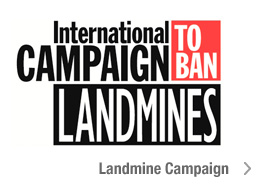Maputo Summit: 3rd Review Conference Documents
| Mine Action |
|
Mine Action and Support for Mine Action 1999–2014 Support for Mine Action |
| Victim Assistance |
|
Afrique - Assistance aux victimes depuis 1999 Africa - Victim Assistance since 1999 Americas - Asistencia a las victimas desde 1999 Americas - Victim Assistance since 1999 Asia - Victim Assistance since 1999 Europe - Victim Assistance since 1999 Middle East - Victim Assistance since 1999 Casualty Trends 1999–2013 |
Press releases are available in English, French, Spanish and Portuguese (click here).
Publlication descriptions are as follows:
Ban
- Banning Antipersonnel Mines: A 15-Year Overview of Major Findings – This 5-page factsheet examines trends in treaty universalization, use of antipersonnel mines, stockpiles and stockpile destruction, production and transfer, mines retained for training, and transparency reporting.
- Mine Ban Treaty Special Issues of Concern (Articles 1, 2, 3) – This 9-page factsheet addresses sometimes controversial issues related to treaty implementation and interpretation, including assistance in joint military operations with states not party, foreign stockpiling and transit of antipersonnel mines, the applicability of the treaty to antivehicle mines with sensitive fuzes or sensitive antihandling devices, and the inappropriate retention of mines for training purposes.
- Update of 1999 Major Findings – This special graphic adaptation uses Landmine Monitor Report 1999major findings and adds new pop-outs to show where key indicators of progress stand today.
Mine action
- Mine Action and Support for Mine Action: 1999–2014 – This 5-page factsheet details global mine contamination and clearance efforts, especially progress made by States Parties in completing their obligation to clear all known mined areas. It features an update on international cooperation and national support to mine action that includes calendar year 2013 figures.
- Support for Mine Action (infographic) – This infographic contains 5-year summaries of trends and totals in global mine action funding, and provides key figures on recent top donors and recipients of mine action support.
- As a separate publication, Norwegian People’s Aid will release Clearing the Mines, a 200+page report that assesses the remaining threat from antipersonnel mines. The report is based on research by the Monitor’s Mine Action team.
Casualties and victim assistance
- Casualty trends 1999-2013 – Using data collected on casualties occurring in the 31 States Parties with significant numbers of survivors and needs from 1999 through 2013, this 9-page report highlights the decline in casualties since the Mine Ban Treaty entered into force. Despite this decrease, the number of survivors continues to grow. Over the 15-year period, the percentage of civilians impacted increased and children killed and injured remained almost half of all known casualties. The report examines demographic trends related to incidents caused by antipersonnel mines, victim-activated improvised explosive devices (IEDs), antivehicle mines, and explosive remnants of war (ERW).
- Victim Assistance Regional Reports (5): Africa, Americas, Asia, Europe, Middle East – In a series of reports, the Monitor presents victim assistance trends in five regions, focused primarily on states with significant numbers of survivors and needs. Each report details State Party-specific actions related to availability and access to services, as well as survivor inclusion and participation. These reports also provide an overview of international cooperation and national support for mine/ERW survivors in each region. The Americas report is available in Spanish; Francophone Africa is available in French.
- Mine/ERW Casualties in the Africa Union (infographic) -This infographic details overall mine/ERW casualties within Africa Union states from 1999-2013, as well as specific casualties data for 2013.


